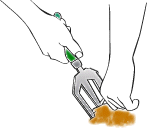Planting something that is usually hard to kill off [ like Sempervivum (hens and Chicks)] can turn a small corner in the garden into a really nice feature.
Sempervivum is a succulent making it an ideal summer plant to hang out under foliage. Especialy if the summer is a dry one and the watering gets forgotten.




